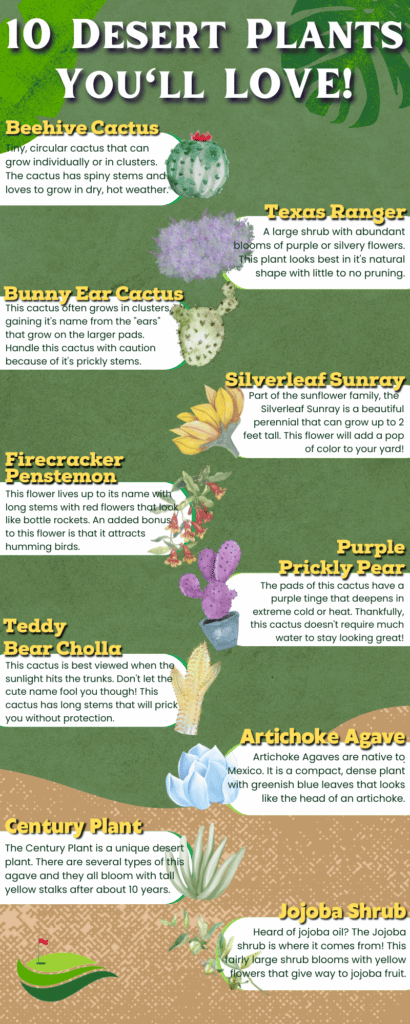Deciding how to landscape once you have chosen to lay artificial turf on your yard can be difficult. The Southern Nevada Water Authority, which serves Las Vegas (where Everything Turf Pros is located!), provides example designs for property owners who need an idea of how to design their land.
Many of these designs include desert plants native to the southern Nevada region. Don’t know where to start? Luckily, the SNWA has a plant list that includes water-smart trees, cacti, succulents, and many more desert flora. Let’s look at ten beautiful desert plants that thrive in dry climates!
Beehive Cactus (Spinystar)
This tiny cactus, also known as “spinystar,” is native to North America and often appears in clusters of several plants. The plant is ball-shaped and has short, spiny white stems sprouting from its sides. What makes beehive cacti unique are the bright pink flowers growing from the top of the plant during the spring. As a bonus, beehive cacti’s beautiful flowers give way to green, red, or yellow-colored edible fruit.
Beehive cacti are also very hardy, thriving even in the worst of droughts. The cacti prefer dry, well-drained, alkaline soil, even growing in rocky areas. The SNWA also notes that the cactus can survive cold spells and are resistant to pests and insects once established in an area.
Texas Ranger (Texas Sage)
This shrub is for those who love big plants with abundant blooms! This shrub grows to 3-5 feet in width and height and can span 20 square feet when fully developed. Texas Rangers have bright green or silver-colored leaves, and all plants bloom with purple or silvery flowers. There are several varieties of the Texas Rangers for you to choose from — the SNWA lists 13 different types!
Texas Rangers flourish in full sun and require little water to grow. The University of Florida Institute of Food and Agricultural Sciences writes that Texas Rangers need well-drained alkaline soil to grow to their full potential. They also recommend against heavy pruning to keep the plant’s natural shape and bloom. The Texas Ranger is especially great for wildlife lovers as the plant attracts butterflies and hummingbirds.
Bunny Ear Cactus
Native to Mexico, these cacti get their name because of the small “ears” sprout from the main plant. The plant is a small-to-medium cactus that grows to three feet and can span 20 square feet when fully grown. Bunny Ear cacti will occasionally bloom with yellow or white flowers.
Bunny Ears don’t require much water like other desert plants and thrive in full sunlight. Don’t be fooled by the adorable name, though! Bunny Ear cacti have thin red, yellow, or white-colored spines that will prick you if you handle the pads without protection. The white variety can survive the coldest weather, says the SNWA. Like many other cacti, the Bunny Ear cactus produces edible, brown-colored fruit. The Bunny Ear cactus also looks excellent as a houseplant!
Silverleaf Sunray
The Silverleaf Sunray is a part of the sunflower family and is a native of the Mojave Desert. This perennial can survive in extreme heat and very little water. The flowers are a bright yellow color and are three to four inches in diameter, writes the Chicago Botanic Garden.
Like a classic sunflower, the sunray grows upward and faces the sun. But unlike the sunflower, the Silverleaf sunray only grows to about two feet in height. The SNWA suggests adding perennials to your yard in small accent areas. Choosing the Silverleaf sunray will add a pop of color and uniqueness to your yard!
Firecracker Penstemon
This flower lives up to its name with long stems of bright red blooms that resemble bottle rockets. This plant can reach one to five feet tall and grows quickly in full sunlight. The Firecracker Penstemon is native to the Mojave Desert and several other areas in the southwestern United States, including Colorado, Idaho, Utah, and Wyoming. The Firecracker Penstemon attracts hummingbirds and is rabbit-resistant, writes the SNWA.
This plant doesn’t require much water or maintenance to stay beautiful. The SNWA recommends minimal care for the Firecracker Penstemon, only cutting off the stem from the base once the flowers wither.
Purple Prickly Pear
The Purple Prickly Pear, also known as the Santa-Rita Prickly Pear and the Purple Pancake, is a cactus with clusters of flat, purple pads. The cactus blooms in spring, bearing yellow flowers that give way to brown fruit in autumn. Like the color of the cactus? Purple Prickly Pears love to grow in full sunlight, and their purple hue will deepen in color in extreme cold or heat. Purple Prickly Pears grow best in well-drained, alkaline soil. They also do well in rocky or sandy soil because of their desert-native characteristics!
This medium-to-large-sized cactus doesn’t require much water or maintenance. One of the few things that bother the Purple Prickly Pear is the cochineal bug. Cochineals are small, scaly bugs that cover themselves in a white substance, sticking to the cactus pads in clumps. Spray off those bugs with a bit of water, and your Purple Prickly Pear will look good as new!
Teddy Bear Cholla
Another native to the Mojave Desert, the Teddy Bear Cholla is best viewed when the sunlight hits its prickly stems. Cholla comes from the Spanish word skull or head, eventually coming to mean a cylindrical cactus plant. The Teddy Bear Cholla has several oblong trunks that grow golden spines. Like other cacti, the spines can prick you; the SNWA recommends collecting fallen cholla trunks and spines with a shovel.
Besides the beautiful living cholla cactus, cholla wood (the dried skeleton of a cholla cactus after it dies) is loved by aquatic enthusiasts because of its benefits for shrimp! Cholla wood looks a lot like a piece of driftwood—brown, hollow, and sometimes holey. The wood produces biofilm while submerged in an aquarium, providing a food source for shrimp.
Artichoke Agave
Did you know that all agaves are a part of the succulent family? Cacti are also succulents, but not all succulents are cacti.
Artichoke Agaves are found in a specific region of Mexico: the Durango-Zacatecas grasslands. The Artichoke Agave is a compact plant with leaves that grow curved and upwards, resembling the artichoke vegetable. The leaves are thick, silvery-green, and can look blue in some lighting. This agave plant likes rocky and well-drained alkaline soil to grow in. Make sure to plant this desert native where there is a lot of sunlight! Artichoke Agaves thrive in full sunlight.
Century Plant
The Century Plant family has several beautiful drought-resistant types to choose from. A unique feature of these succulents is the vast flower stalks that bloom after the plants are about ten years old. The flower stalks grow quickly, blooming with yellow flowers, and vary widely with height depending on the variant.
The Medio Picta Century Plant is a bicolored agave that requires little watering to grow. The plant leaves are a striking light yellow with a green border. The Medio Picta looks good in any garden individually or with other plants, giving the scene a pop of color! Medio Pictas are also cold-hardy and do well in sandy, rocky, and alkaline-based soils.
Another unique Century Plant is the Yellow Margin Century Plant. The Yellow Margin plant is almost the exact opposite visually of the Medio Picta—the large leaves have bright yellow borders and green middles.
Jojoba
You might have heard of jojoba oil being used for hair and skincare. The Jojoba shrub is where that oil comes from! Jojoba shrubs bloom with small, yellow flowers in the spring, and the jojoba fruit grows in the summer and fall. The oil that comes from the fruit is processed to make commercial jojoba oil.
The Jojoba shrub has thick, leathery leaves 1 to 2 inches wide. The plant requires little water to grow and does best in full or partial sun. It is a relatively large plant that can get up to 6 feet in height and width-wise. There are compact varieties available for those looking for a smaller, more compact Jojoba plant.
Like What You See?
Found the next plant to add to your artificial turf plan? These desert-native plants are amazingly drought-resistant and have characteristics that make them excellent for various yards. They will survive even the hottest weather, adding color and individuality to a yard with an artificial lawn. These water-smart plants also help save you money on your water bill, thanks to the low water consumption. Having a functional yard is great, but having a functional and beautiful yard is even better!




